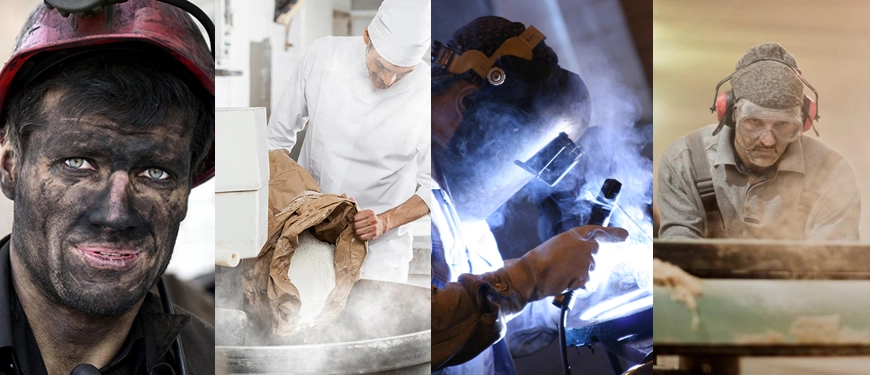
Occupational Respiratory Diseases: Avoid Biting the Dust
After getting a breath of fresh air during the Christmas break, we’re back! We’re taking this opportunity to wish you a happy and healthy new year. Inspired by COVID-19, we discuss the prevention of occupational respiratory diseases. Every year, workers struggle with lung diseases following often-avoidable exposure to dust in the workplace. Nobody wants to see their employees face an industrial and potentially life-threatening respiratory disease. The first step in protecting your employees: understanding the hazards.
How dust affects the lungs
Every day, our lungs are exposed to hazards associated with the dust that we breath in. Although defence mechanisms provide some protection, breathing in excessive amounts of harmful dust can cause serious occupational respiratory diseases.
Some workplaces are more at risk, including the welding, metallurgy and construction industries, paint shops, and industrial bakeries.
Diseases associated with dust in the workplace
- Chronic obstructive pulmonary disease (COPD), for example: bronchitis and emphysema
- Asthma
- Hypersensitivity pneumonitis (extrinsic allergic alveolitis)
- Fibrosing alveolitis (pulmonary fibrosis)
- Pneumoconiosis, for example: silicosis, talcosis and amiantosis
- Cancer
- Heart disease
Main types of problematic dusts
Hold your breath: according to the CNESST, there are roughly 250 agents likely to cause occupational asthma. Even flour is a major source of work-related asthma. Not to mention the various toxic particulates that can float in the air.
Carcinogenic substances often encountered in the workplace:
- Silica dust (crystalline silica/quartz): Exposure results in progressive respiratory disorders, ranging from shortness of breath to a very serious respiratory failure – both indoors and outdoors! It can cause serious life-threatening lung diseases such as silicosis.
- Styrene: This carcinogenic material used for manufacturing plastics and rubber creates genetic damage in the white blood cells or lymphocytes. Associated cancers: hematopoietic (leukaemia and lymphoma), pancreas and esophagus.
- Asbestos: Asbestos fibres can cause serious respiratory diseases like pleural plaques and pulmonary fibrosis (amiantosis). Associated cancers: larynx, lung, colon and mesothelioma.
- Hardwood dust: Created during operations like planing, sanding or sawing, this dust can cause eye, nose and throat irritation. In the respiratory system, it can reduce lung capacity and trigger allergic reactions. Associated cancers: nasal cavity, paranasal sinuses, and nasopharynx.
- Hexavalent chromium or chromium VI: This material from the fumes created when welding galvanized steel can cause such things as irritation of the nasal mucosa, asthma, cough, shortness of breath, wheezing and can lead to chromium allergies. Associated cancer: lungs.
How do you know if your employees are at risk?
First by determining the exposure value. When it’s likely that the concentration of an agent in the air is dangerous, you must turn to a professional. He/she will take air samples and calculate the exposure value in the air for duration “X” using specialized equipment that he/she will install on the employees’ clothing.
Under the Regulation respecting occupational health and safety (S-2.1, r.19.01), the sampling professional will measure:
- Short-term exposure value (STEV). This value establishes the average concentration of exposure to a chemical substance. Exposure over a period of 15 consecutive minutes can range between the TWAEV and the STEV, provided that it does not occur more than 4 times a day. It must also be interspersed with periods of a least 60 minutes. For example, the STEV for flour dust is 30 mg/m3, whereas it is 10 mg/m3 for the TWAEV.
- Adjusted average exposure value (AAEV). This is a measurement determined using the Guide for the adjustment of permissible exposure values (PEVs) for unusual work schedules.
- Time-weighted average exposure value (TWAEV). This value expresses the average concentration of a chemical substance within a worker’s breathing zone. The value is weighted over one 8-hour period per day (40 h/week). For example, the TWAEV for copper dust is 1 mg/m3.
Ready to suffocate occupational respiratory diseases?
Fortunately, exposure to toxic airborne substances in the work environment can be controlled. We will discuss solutions for protection and dust removal from the breathing zone in the next article. In the meantime, if you believe that your employees may be at risk, don’t hesitate to call us.
Get in touch with our experts!


